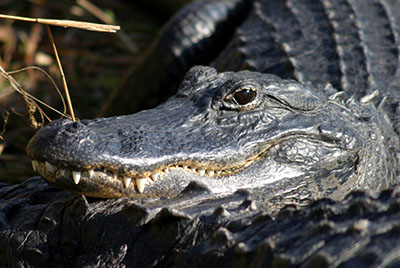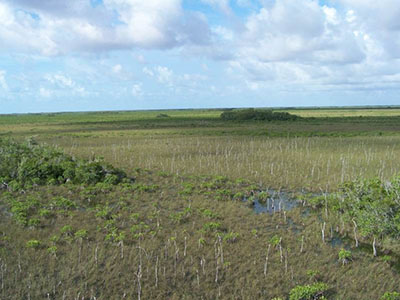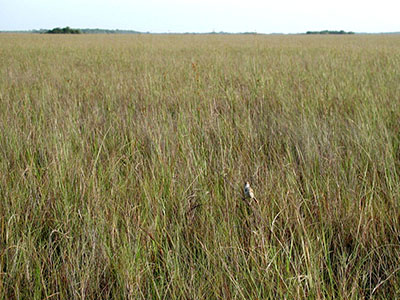
Rising sea levels pose threat to Everglades
When people think of the Everglades, they often picture vast wetlands, nesting birds and alligators lurking in the sawgrass.
But, rising sea levels are starting to change how that picture looks.
For the Everglades, being at risk from encroaching factors is not a new experience. From early development of Florida, to diversion of water sources, the Everglades have been encroached on by people’s desire for more useable space. Now, with the growing concern over climate change, the threat to the Everglades takes the form of salt water encroachment.
 |
As saltwater levels increase, animals like the alligator are migrating to remaining freshwater sources (Photo courtesy of the National Park Service). |
“You have to be careful about what we call climate change damage. We know that sea levels are rising, and we can certainly see effects from that, but we also know that we have a lot of storm surges down here and we have a very variable climate,” said Everglades National Park ecologist and climate change expert Leonard Pearlstine. “As the sea comes up the storm surges are able to get deeper into the interior”.
The effects of sea level rise on the Everglades are not something that affects only environmentalists. Additional sea level rise and with it increased saltwater encroachment, affects the fresh water supply for all of South Florida.
According to Dr. Harold Wanless, a geologist for the University of Miami, a minor increase in sea level rises in the next few years will force water managers to make tough decisions regarding how they will combat saltwater intrusion.
“They say that with a 20 centimeter farther rise in sea level (about eight inches), that 65 percent of these water control structures between here and Palm Beach County won’t work anymore. Meaning to keep the saltwater out we’re either going to have to raise the water levels landward to the point that we start flooding out communities and roads. Or we can keep the water levels down but saltwater intrusion will happen,” Wanless said.
In recent years the Everglades have started to experience a shift in the eco-system of coastal areas from habitats that are supportive of freshwater communities, to a growth in plants that thrive in saltwater. It can be seen in local wildlife with saltwater-tolerant crocodiles moving into waters formally inhabited by alligators.
“We have a fair number of rare species that are dependent upon the hammocks along the coast and as they become more saline those species become more threatened,” cautioned Pearlstine.
One under-noticed aspect of saltwater intrusion is that the peat soil levels have been reduced, bringing the Everglades closer to sea-level. This makes it easier for saltwater to come up and affect the water tables. The local mangroves are particularly important to the local ecosystem because they help to build elevation to counteract sea level rise.
“The important thing about mangroves is… the habitat that they provide for a myriad of estuarine creatures,” said Dawn Shirreffs, Everglades Restoration Program manager for the National Parks Conservation Association. “It’s maintaining the balance of freshwater and saltwater in our estuaries, because the minute they become hyper-saline it degrades all of the environment.”
|
Dead cypress and encroaching mangrove along the eastern side of coastal Everglades National Park (Photo courtesy of Jimi Sadle, Everglades National Park). |
 |
“Saltwater predominated habitats tend to be mangroves and saltwater marshes. The problem that people have begun to see is that saltwater is intruding into the marshes faster than the mangroves can keep up,” said Rachael Johnson, who is studying geology and ecosystem policy at the University of Miami. “Usually, if you had a slow sea level rise, saltwater would intrude slowly and the mangroves would have time to migrate backwards.”
Wanless points to nearby Cape Sable as an example of how quickly saltwater can overtake fresh and shift the nature of a location.
“The interior was a freshwater marsh just like the Everglades… but we did a study on Cape Sable from around 2000 to 2005 and it has basically lost all of its freshwater marsh because of rising sea levels. It’s one of the first places where we’re seeing major coastal change and major change in the wetlands. When the freshwater marsh dies because of saltwater encroachment it immediately collapses and dies,” Wanless noted.
One concern that faces those tasked with preserving the Everglades is that the saltwater is advancing faster than mangrove groves can retreat with it and keep it at bay. This is especially concerning on a more global scale because of the effectiveness of mangroves as sinks for carbon-dioxide.
“Mangroves are very interesting trees,” observed Wanless. “The red mangrove, half the biomass is in the root system. They are probably the best sequester of carbon that we have. If you plant mangroves they create a lot of organic matter in the soil living in dead roots.”
Part of the issue is that the porous limestone base rock allows saltwater to permeate and flow under any attempts that could be made to block encroachment from above, and prevents attempts to pump out saltwater by limiting ability to control where the saltwater flows.
With the issue established, how can the Everglades be preserved from future damage and even reverse the effects of encroaching saltwater? Experts like Wanless and Pearlstine work on this issue with limited success, and often differ on what the best strategy for recovery is.
“The most important things we can do for both the plants and animals of the Everglades and the ecosystem is to get fresh water down here,” Pearlstine said. “With these extreme events we are subjecting our eco-system to pretty rapid and harsh changes. By bringing fresh water down into the Everglades National Park and down to Florida Bay, it’s mitigating a lot of that. It’s helping to hold saltwater intrusion back, creating buffers and more stable eco-systems for our plant communities.”
When the Everglades have enough fresh water in them they act as a buffer to saltwater intrusion. However, water levels are often compromised by the need to protect inhabited areas.
“The Biscayne Aquifer is our drinking water supply and the way that our limestone aquifer has developed it is easily contaminated by saltwater if there is sea-level rise,” said Shirreffs. “We know that the only thing that can keep the Biscayne Aquifer free from that is maintaining enough force in the freshwater flow to keep the saltwater out. Once you get saltwater into an area of the aquifer, it cannot be functional for providing freshwater for Florida’s families for an estimated 100 years.”
But the issue of where the water should come from remains an issue. After failed attempts to store excess water in the ground near Lake Okeechobee, the newest question is if water from sugar agriculture should be used. However, this source creates nutrient rich water which is not good for the native sawgrass, and instead encourages the growth of invasive cattails.
 |
Damage from saltwater intrusion is hurting freshwater prairies in the Everglades (Photo courtesy of Everglades National Park). |
“The question was ‘well, how fast can sawgrass build peat’? And the answer according to the biologist at the Everglades is about a foot per century. Well that’s not fast enough so you’re going to get screwed; it’s not going to work” said Wanless. “So my response was let the nutrients come down, let the cattails go wild, build up your water levels, build up your soil levels and then convert it back to the community that you want”.
However, legal roadblocks stand in the way of using nutrient rich water to increase freshwater flow in the Everglades.
“The law does not allow us to put water that has been compromised into Everglades National Park because it would destroy the ecosystem. It’s a nutrient sensitive ecosystem,” said Shirreffs. “That is one of the major constraints holding us back from putting freshwater flows into the Everglades today. If we cannot resolve the water quality issues that we have due to agricultural production in the Everglades area, then we are not going to be able to restore freshwater flows.”
But with current government projections showing sea level rises of 4.4 to 6 feet by the end of the century, Wanless sometimes wonders if it is even worth continuing to try and preserve something that probably will not be there in 50 to 100 years.
“One could wonder if we’re going to flood out sometime this century if we should even be bothering with the Everglades restoration. And I think from a human, selfish point of view the answer is yes. Because if we can raise the water level in the Everglades a little bit, we can maintain the freshwater head difference a bit and keep the saltwater at bay and keep our source of fresh drinking water longer.”
Even if conservation efforts have success, the future of the Everglades and Florida as a whole is tied to climate change.
As Wanless put it “When you start to look at the future of Florida you can’t look at Florida, you have to look at Greenland and Antarctica.”
But for right now, the Everglades are still an important contributor to the fight against climate change, and will be until the oceans overtake it, or it helps to win the fight.

Comments are Closed